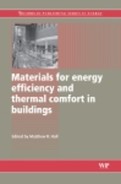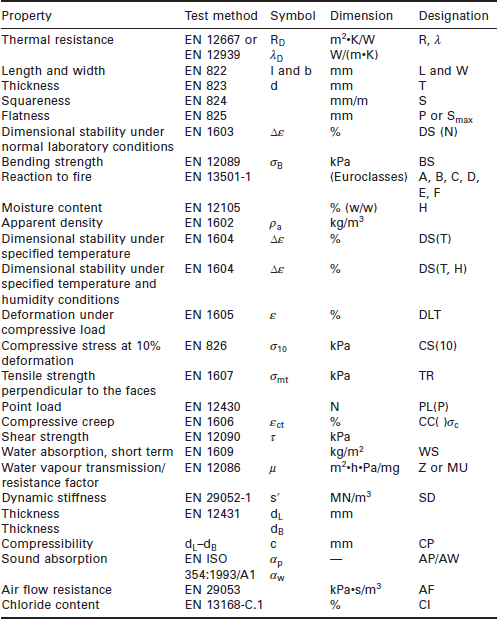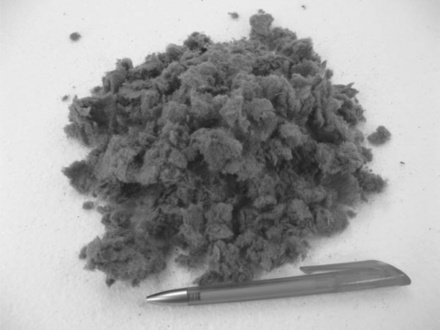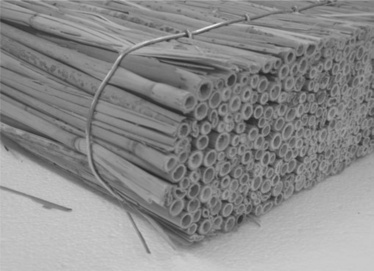Natural fibre and fibre composite materials for insulation in buildings
Abstract:
Insulating materials from natural organic raw materials have gained a small (4–6%) but growing market share in Europe in the last fifteen years. On the one hand, this consumer acceptance is based on the fulfilment of regulatory requirements, i.e. conformity with recently published European standards and/or the issue of European Technical Approvals (ETA). On the other hand, the growing awareness of the public towards ecological performance of building materials has given niche-type products from natural sources a certain boost, and increasingly recently-erected – often called ‘green buildings’ or ‘eco-buildings’ – can be found throughout Europe.
9.1 Introduction
Insulating materials and products are usually classified into two major groups depending on the raw materials used for their production, i.e.
The latter is further subdivided into
Although the so-called natural products may contain varying amounts of additives such as fire retardants, binders or substances to improve mechanical and moisture repellent properties, they are usually offered as ‘natural’ to the market.
Products based on the raw materials in Table 9.1 can be found in the market for this particular application.
Table 9.1
Natural organic raw materials employed for the manufacture of insulating materials and products
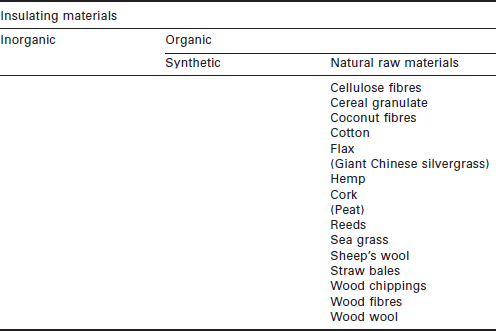
Some of the materials listed in Table 9.1 are relatively rare or no longer commonly used, in particular peat and giant Chinese silver grass. Generally speaking due to the increasing cost for energy, the sale – and use – of insulating materials and products for the housing sector has risen in the European market during the last two decades. Table 9.2 illustrates the market growth since 1989 for Germany – with a slump of 20% in recent years – but the market recovered in 2006 and 2007. As can be noted the market shares have hardly changed over the years due to the individual price/performance characteristics of each product (group) compared with the others. Products based on natural organic raw materials have gained some market share in recent years – most likely not only based on their performance but also based on their (more) ecological image. Within this group one can find the market share distribution in Germany shown in (Table 9.3). Most of the aforementioned products are supplied to the market in one of the four forms of supply listed in Table 9.4.
Table 9.3
Market share of insulating materials from natural organic sources (Germany 2004) [1]
| Product | Market share (%) |
| Cellulose (LFCI) | 32 |
| Wood fibre (WF) | 28 |
| Wood wool (WW) | 20 |
| Flax/Hemp | 9 |
| Sheep’s wool | 4 |
| Others | 7 |
9.2 Regulatory requirements
In order to bring transparency into the European market for manufacturers and designers, and to guarantee legal security for all those involved, national regulations have been subject to a process of harmonization at the European level. The current transitional phase is characterized by the coexistence of European and national regulations, the validity of which must be carefully considered.
It was in 1989 that the ‘Council Directive 89/106/EEC of 21 December 1988 on the approximation of laws, regulations and administrative provisions of the Member States relating to construction products (89/106/EEC)’ was published in the Official Journal of the European Communities (OJ). This so-called Construction Products Directive (CPD) states that construction products – and the technical specifications that describe them – must be of such a form that their use does not have a detrimental effect on the levels of safety and protection that apply to the construction works. Such levels can vary, depending on the location of the works, their use or other circumstances.
The levels of safety and protection are divided into six primary requirements listed in Annex I of the CPD:
For the implementation of the CPD, the European Commission has provided detailed explanations and commentaries of individual parts in the form of interpretive documents and Guidance Papers; the Member States and the CEN (Comité Européen de Normalisation – European Committee for Standardisation) have to take into account these non-binding documents in their national legislation.
The above-mentioned technical specifications that describe construction products, e.g. thermal insulating materials and products, will normally be either harmonized standards or European Technical Approvals.
• Harmonized standards (hEN) [2–4] are technical rules drawn up on the basis of mandates of the Commission of the European Communities by the European standardization organizations with respect to the essential requirements; they are implemented in corresponding national standards (e.g. as DIN EN or BS EN). Normally, national and state governments contribute to the drafting of harmonized standards within the scope of the participation of interested parties in order to incorporate into European standardization the latest technical requirements.
• European Technical Approvals (ETA) are favourable technical assessments of fitness for an intended use issued to a manufacturer for his construction products by certain Approval Bodies according to this law or the legislation adopted by other Member States of the European Union or other contracting states to the agreement on the European Economic Area (EEA).
Binding legislation on the one hand and standards and approvals on the other hand have created an extensive set of rules and regulations covering the manufacture of insulating materials and their use in construction. The standards and approvals are by definition not mandatory, but do become so when statutory instruments make reference to them.
Table 9.5 lists the existing standards, preliminary standards or approvals for the insulating materials and products described in this chapter.
Table 9.5
European technical specifications for insulating materials based on natural organic raw materials [2–4]
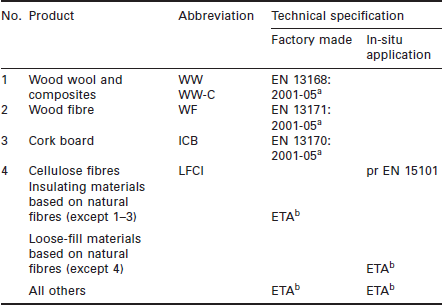
aRecent additions and corrigenda have been published (www.cen.eu).
bIndividual companies are holders of approvals (www.eota.be).
As the standards for the factory made products were written according to a ‘model standard’ and published as a ‘package’, the three standards listed in Table 9.5 all have an identical structure: in the ‘heart of the standard’ one will find the requirements, the test methods, the designation code, the rules for the attestation of conformity and the rules for marking and labelling. Due to the ‘in-situ-situation’ the standard – still in the preliminary stage – for cellulose fibre is written in two parts: one addressing the (basic) raw material, the second part describing the ‘conversion’ from a loose-fill material into a thermal performance product on site. Based on properties to be declared for all applications and also – if declared by the manufacturers – for specific application one can summarize important standardized performance criteria in a table (Table 9.6).
As shown in Table 9.5, most products under consideration here are placed on the market via a European Technical Approval (ETA) – issued specifically to the particular manufacturer. An ETA can be granted when any of the following conditions apply:
• no relevant harmonized standard for the product exists
• no mandate for such a standard has been given by the European Commission
• the European Commission considers that a standard cannot be developed (yet)
• a product deviates significantly from the relevant harmonized standards.
In conjunction with an ‘Attestation of Conformity procedure’ (which is intended to ensure that the product specification set out in an ETA is maintained by the manufacturer), ETAs allow manufacturers to place the CE marking on their product(s).
Although in certain circumstances it may be possible for an ETA to be issued on the basis of a common assessment procedure agreed among EOTA members (according to the art. 9.2 of the Council Directive 89/106/EEC), in most cases an ETA for a product will be granted to a manufacturer based on the assessment principles set out in an ETA Guideline for the relevant product sector. When a European Technical Approval has been issued it is valid in all EEA countries, for a period of five years, renewable thereafter.
The European Organization for Technical Approvals (EOTA) lists ETA documents, the type of products and the manufacturer on its home page (www.eota.be).
Both routes lead to the CE marking on the insulating products.
9.3 Building-related properties
Because of its importance as the most important building-related property, in the European system for declaring the thermal conductivity λD (or the thermal resistance RD respectively) the following details can be given:
• The declared thermal conductivity λD is determined on the basis of statistically evaluated measurements (λ90/90) – to be organized by the manufacturer. Details are given in the respective product standard (usually in a normative Annex); λD is declared in steps of 0.001 W/m • K.
• Design values for the particular building application are defined nationally – due to different building codes and/or the climate in question.
An overview of the basic building-related properties is given in Table 9.7, some specific properties of interest here in Table 9.8.
Table 9.7
Typical building application related properties [5–7]

aDeclared thermal conductivity by the manufacturer.
Table 9.8
Selected specific properties based on manufacturers’ declarations (where given) [5]

aEN 826
bEN 1607
cICB not bitumenised
Besides the ‘core properties’ which determine the performance of an insulating material, some products have good acoustic or specific fire performance characteristics that the manufacturer wishes to declare – or has to declare for a certain application – already when placed onto the market, i.e. the reaction to fire classification. The latter has now been based on the European (classification) standard EN 13501 and the following Euroclasses with respect to the combustibility of building materials (reaction to fire) have been agreed upon:


Table 9.9 summarizes those properties.
Table 9.9
Properties related to acoustic and fire performance (manufacturers’ declarations – where given) [5]

The properties outlined above in the various tables –in short the performance characteristics –have led the products made from natural raw materials to be used in certain applications which can best be visualized in a matrix (Table 9.10).
Table 9.10
Application matrix (based on the German DIN V 4108–10) [5], [7]


![]() with building authority approval for the product for this application
with building authority approval for the product for this application
Based on the European technical harmonization, the EU Member States are responsible for developing rules for the specific use of insulating materials in construction works, e.g. in roofs or walls –as outlined in Table 9.10 for Germany as an example.
9.4 Ecological and health aspects
So far those product characteristics that have been described reflect the more technical performance, i.e. mechanical strength, fire protection, sound insulation and, of course, thermal insulation.
The ‘Essential Requirement 3 (ER 3)’ of the European CPD demands that construction works should not endanger users through any of the following:
• the presence of dangerous particles or gases in the air
• the emission of dangerous radiation
• the pollution or poisoning of the water or soil
• the faulty elimination of wastewater, smoke, solid or liquid wastes
• the presence of damp in parts of the works or on surfaces within the works.
Given the origin of the products described in this chapter, they will most likely contribute to a healthy ‘building environment’. In order to fulfil all mandatory building-related performance criteria, additives have to be used to meet these requirements.
• Reaction to fire: since in many countries at least Euroclass E has to be fulfilled by construction products, flame retardants are being added; in use are usually aluminium hydroxide, ammonium phosphate, -sulfate, borax, boric acid and others.
• Mechanical performance: in order to improve the dimensional stability artifical (polyester) fibres are added.
• Resistance against biological attack: the proof of the resistance of the product is usually based on an EOTA test procedure (‘factory-made thermal insulation material and/or acoustic insulation material made of vegetable or animal fibres’ Edition June 2003, Rev. 1 June 2005). The (possible) growth of fungus has to be judged based on EN ISO 846: 1997-06, Table 4 and should yield the classification ‘0’.
The so-called ‘eco-balance’ takes into consideration all stages of the life cycle, i.e. acquisition, production, use and end-of-life plus transportation for combining the different stages. For a specific use-phase Table 9.11 gives a comparison of the most important ecological parameters.
Table 9.11
Ecological performance based on standardized conditions (U-value = 0.3 W/m2K; PE-investment = 0.22 W/m2K) [1]

aCalorific value: Can be gained in a later combustion process.
bPE-Input: Primary energy input covering all energy used to manufacture the product.
cGWP: Global warming potential.
dAP: Acidification potential.
Provided that in the near future data and parameters for all insulation materials are generated on a standardized basis, the end-user can choose their product both on the technical and the ecological performance checklist. However, one should keep in mind that no matter which approved insulating product is chosen, the ‘return-on-energy investment’ is – depending on the climate – usually one heating period.
9.5 Individual product profiles
9.5.1 Woodwool (composite) boards (WW) (Fig. 9.1)
The boards or slabs are made from long shavings of softwood and are bonded by the use of an inorganic cement agent. In the composite woodwool slabs the woodwool is bonded with a mineral binder; on one or both face(s) another insulating materials, e.g. mineral wool or a foamed rigid cellular plastic can be bonded.
9.5.2 Wood fibre (WF) (Fig. 9.2)
Insulation products are manufactured from wood fibres with or without the addition of bonding agents and/or additives; some products are only mechanically bonded. Depending on the bonding agent the product(s) can be supplied either as mats, batts, felt, rolls or lamella rolls. In the latter case strips of wood fibre boards are bonded to a flexible facing and supplied in a bond. This will lead to a continuous insulating layer when the product is unrolled.
9.5.3 Cork-board (ICB) (Fig. 9.3)
The protective layer of the cork oak tree (Quercus suber L.) is periodically removed from its trunk and branches to provide the raw material for cork products. The cork is granulated by grinding and/or milling. From this the pre-formed product is made by expansion and bonding exclusively with its own natural binder by heating under pressure.
9.5.4 Cellulose fibres (LFCI) (Fig. 9.4)
Loose-fill cellulose insulation (LFCI) is a fibre or fibrous or granulated insulation material derived from paper, paper stock and/or wood, leaf or stalk strings with or without binders. The product is blown, injected or applied with or without moisture. The insulation system usually consists of a particular type of loose-fill cellulose used in conjunction with a blowing machine with a blowing hose and nozzle attached to a hole which is cut or formed into a masonry cavity or frame construction through which the cellulose is blown.
9.5.5 Hemp (Fig. 9.5)
Insulating products are either made from the fibres of the hemp plant (Cannabis sativa) or the shives (Fig. 9.6). Supporting fibres (usually from polyester) are used to give the mats mechanical support; starch is sometimes used to bind small layers of hemp fibres. Additives (salts of boric acid) are used to give the product its flame retardant property. Shives can be impregnated and then either formed into boards or used as loose-fill material. The proper ratio of hemp shives and lime has been combined into a bicomposite building material with excellent thermal and acoustic properties.
9.5.6 Sheep’s wool (Fig. 9.7)
Raw or recycled wool from sheep is run through a cleaning process and then treated with additives such as the salts from boric acid or urea derivatives to give it flame retardant and moth repellent properties. Often supporting polymeric fibres (polyester) are added.
9.5.7 Cotton
Similar to sheep’s wool, cotton can be converted directly into an insulating material, using the same additives to give the rolls or batts the needed properties for the building application. Rarely loose flakes of cotton are used as blown insulation material.
9.5.8 Flax (Fig. 9.8)
Only the short fibres of the flax plant are used to manufacture a fleece; additives similar to the ones used for hemp mats are used to give the product the needed performance characteristics.
9.5.9 Cereal granulate (Fig. 9.9)
An extrusion process is used to obtain this loose-fill insulation material from fine rye grains, rye pulp and other additives – especially to introduce the needed resistance to mould, insects and rodents. The product is used in particular when cavity walls in wooden constructions have to be insulated.
9.5.10 Reeds (Fig. 9.10)
The stalks of reed plants are positioned in a great number, pressed slighty and then bound together with the help of iron wire or nylon threads. Further additives are not used. However, the product is only used in regions where there is a tradition of employing this material.
9.5.11 Coconut fibres (Fig. 9.11)
The fibres of the coconut shell are used to produce this insulating material; for 1 m3 of product, roughly 700 to 1600 coconuts are needed. Additives are employed to give the product flame retardant properties.
9.5.12 Wood chippings (Fig. 9.12)
This insulating material is usually part of an industrial process where prefabricated wooden houses are being manufactured. The waste chippings are impregnated with additives to give them a fire retardant property – and then blown as loose-fill into, e.g., cavity walls; some compaction is required.
9.5.13 Straw bales (Fig. 9.13)
As a by-product of agricultural production this raw material is readily available. After cutting the straw to the right length and reducing the moisture content, the product can be used as a loose-fill material or – similar to reed – converted into batts of rather thick proportions.
9.6 Reference buildings
Although many of the above-mentioned materials have been used for generations in different climate conditions – often as traditional building material – only recently can reference objects be cited where the use is extensively documented, especially under energy-saving criteria.
The ‘Agency for Renewable Raw Materials’ in Germany has recently published a list of reference objects – although currently only available in German [8]. Three examples are described in more detail in this section – more extensive literature, e.g. describing the use of straw bales, can be found elsewhere [9].
9.6.1 Example 1: ‘Werlte Climate Centre’ (Fig. 9.14)
This example describes the reconstruction of former barracks into a model house for renewable energy and renewable resources within the perimeters of the ‘Perspective 50Plus’ project and was funded by the Federal Ministry for Labor and Social Affairs (BMAS) of Germany.

9.14 Werlte Climate Centre (Source: www.3-m.info, Emsland, Germany).
From 1968 to 2005 the former company building was part of the ‘Hümmling barracks’. The reconstruction to a model house took place within the parameters of an employment project with simultaneous qualification for elderly unemployed. The building, with a usable area of approx. 2000 m2, was redeveloped while taking aspects of energy saving into consideration and using renewable resources. Heating has since changed to vegetable oil (communal heating/power station), and also supplies the neighbouring office building. The climate centre became a reference facility with role model character.
Several isolating façade systems are an example of the energetic refurbishment of an old building with renewable resources. These are unique nationwide, equipped with over 50 sensors and supplying continual data regarding the temperature and humidity.
The roof is provided half with insulation between the rafters and insulation of the loft. Good insulation and a healthy room climate are also prominent in the selection of windows and flooring of wood, linoleum and tiles. Approx. 99 tons of CO2 and 1600 litres of heating oil are saved every year as a result of improved insulation.
The climate centre was launched in 2008. The responsible bodies are the administrative district of Emsland and the community of Werlte (Germany).
With its exhibition areas and the information it provides, the climate centre has become a forum for companies, consumers and research. Several exhibition areas present modern bio energy technology and regenerative energy efficiency. More than 30 exhibitors present their products and services here.


9.6.2 Example 2: Kindergarten in Döbeln
Directly next to the Jakobikirche in Döbeln, the Evangelist-Lutheran church parish built a new kindergarten. Similar to a convent, the St. Florian kindergarten forms a constructional unit with the church; a cloister with an inner courtyard joins the buildings together. After the 2002 Mulde flood the replacement new building had become necessary. The modern colourful wood construction stands self-confidently next to the 19th century church; both mutually enhance each other in their effect. You enter the single story kindergarten from the street, then your eyes continually wander from the foyer through the large glass façade to the northerly situated church. The carmine red glazed loam wall with built-in cloakrooms separates the hallway from the southerly situated group rooms. Via large doors with glass side sections, the children enter their play rooms with their own wooden galleries and bathrooms. The 68 day nursery and kindergarten children can go directly into the garden from their four group rooms. Everywhere you can detect the wonderful smell of wood and loam; this is thanks to the construction method with healthy building materials and the controlled ventilation. This system is located visibly behind a glass wall over the northerly situated adjoining rooms. The concept of the ecological passive house was very well adopted by the building owners and the children.
| Construction date: | April 2004–March 2005 |
| Size: | 554 m2 (3172 m3), kindergarten for 68 children |
| Energy consumption: | 15 kWh/(m2a) |
| Total costs: | €1.3 m |
| Exterior wall construction: | 2 cm loam rendering on 70 stem reed panels |
| 2 cm OSB sheathing as bracing wood panel | |
| 35 cm cellulose insulation between wood double T-sections | |
| 4 cm soft wood fibre boards | |
| 3 cm rear ventilation | |
| 2.4 cm horizontal larch wood boarding | |
| Floor/ceiling construction: | 2.4 cm industrial parquet |
| 5 cm cement screed | |
| 12 cm heat insulation | |
| 25 cm floor boards | |
| 12 cm perimeter insulation from XPS | |
| Roof construction: | 2 cm OSB sheathing as bracing panel |
| 35 cm cellulose insulation between wood double T-sections | |
| 4 cm soft wood fibre boards | |
| 12 cm rear ventilation space with ventilating rafters | |
| 3 cm planed and edged plank boards | |
| 0.5 cm roof sealing | |
| 6 cm green roof | |
| Wall and floor surfaces treatment: | All interior walls are masonry loam walls with loam rendering on 70 stem reed panels and loam rendering after that glazed with plant pigments |
| Energetic concept: | |
| Heating method: | Passive house, no individual heating method since it is attached to the church |
| Solar industrial water heating: | yes |
| Photovoltaic: | no |
| Rainwater usage: | yes |
| Purification plant: | no |
9.6.3 Example 3: ‘Passive house’ in Esslingen
The property is situated in a new construction area on the outskirts of Esslingen/Neckar (Germany) with a very rigid development plan. Ground area, construction window, number of stories and flat roofs are the guidelines. Flanked by the access road on the north side, the property falls away slightly towards the south. The construction company wanted a four person residential family dwelling that should be constructed as a passive house from ecological and sustainable materials. The building complies with the development plan and was built as a simple cube. The dwelling’s rooms face to the south and their large window areas contribute towards an optimal usage of solar energy. The north and east façades are very limited in their openings, a narrow staircase window serves as a connecting component between the floors. An approved penthouse floor as well as filter and transition zones between inner and outer rooms can be added on at a later date. Enclosures walls of the lower floor are constructed with water impermeable concrete due to the risk of water damage from the slopes and backwater.
The staircase walls act as a system boundary between heated and unheated areas and are constructed with a highly insulated 30 cm strong porous concrete with an additional 18 cm of XPS. Heat bridges in the concrete ceiling are consequently prevented by the insertion of Isokorbs. The walls, ceiling and roof are constructed in wood frame design and are prepared complete in the joiner’s workshop. Straw bales as insulation material were built into the stud cavities and plated, the preconstruction was then transferred to the construction site by a truck crane. In this way the shell could be constructed on site and made rainproof within two days. Thus deviating from the supervisory construction approval, the approval was obtained individually. In regard to the building materials, attention is paid to a sensible and sustainable selection. In particular, regarding this, the straw bale insulation contributes significantly. The straw bales are delivered directly to the joiner’s workshop from the producer by tractor and are therefore, in production, to be appraised with the least primary energy costs. The roof is to be ‘greened’ with a 35 l/m2 storage capable structure. Surplus water is collected in a 3 m3 cistern. The building is to be designed and constructed as a passive house, that is to say, heat loss via the shell surfaces is minimized. The solar energy supplied by the large surface glazing is retained in the house and is transferred via a ventilation system with heat recovery to fresh air. Heating, ventilation and hot water preparation is undertaken by a passive house compact appliance that provides energy with an extracted air heat pump.
| Construction date: | 2008/2009 |
| Size: | |
| Energy consumption: | 15 kWh/(m2a) heating requirements |
| Exterior wall construction: | 12 mm plaster fibre board |
| 50 mm installation layer, soft wood fibre boards | |
| 15 mm OSB sheathing | |
| 400 mm insulated studs (stud cavities filled with straw bale insulation) | |
| DWD 16 mm, UK 24 mm | |
| Larch form boards 24 mm | |
| Floor/ceiling construction: | 16 mm parquet |
| 50 mm tile floor finish | |
| 300 mm EPS 030 insulation | |
| Roof construction: | 12 mm plaster fibre board |
| 24 mm formwork with replaceable faces | |
| Variable vapour barrier | |
| 450 mm insulated studs (stud cavities filled with wood fibre injected insulation) | |
| Wall and floor surfaces treatment: | |
| Energetic concept: | |
| Heating method: | heating and cooling via compact appliance, air fan heating |
| Photovoltaic: | no |
| Rainwater usage: | yes |
| Purification plant: | no |
9.7 Summary
Insulating materials from natural organic raw materials have gained a small (4–6%) but growing market share in Europe in the last fifteen years. On the one hand, this consumer acceptance is based on the fulfilment of regulatory requirements, i.e. conformity with recently published European standards and/or the issue of European Technical Approvals. On the other hand, the growing awareness of the public towards ecological performance of building materials has given niche-type products from natural sources a certain boost, and increasingly recently-erected – often called ‘green buildings’ or ‘eco-buildings’ – can be found throughout Europe.
Since most of these products are fairly new to the market, a careful monitoring of the physical performance, especially with respect to building properties, is advisable.
9.9 References
1. Danner, H. Comparison of ecological insulating materials. www.muenchen.de/bauzentrum, 2008. [Munich].
2. EN 13168: 2001-05 Thermal insulation products for buildings – factory made wood wool (WW) products – specification.
3. EN 13170: 2001-05 Thermal insulation products for buildings – factory made products of expanded cork (ICB) – specification.
4. EN 13171: 2001-05 Thermal insulating products for buildings – factory made wood fibre (WF) products – specification.
5. Pfundstein, M., Gellert, R., Spitzner, M.H., Rudolphi, A., Insulating materials English version: distributed by Birkhäuser – Publishers for Architecture, Basel, Switzerland (2008). Edition Detail, Institut für internationale Architektur – Dokumentation GmbH & Co. KG, Munich, Germany, 2007.
6. DIN V 4108-4: 2004-07 Thermal insulation and energy economy in buildings – Part 4: Hygrothermal design values.
7. DIN V 4108: 2004–06 Thermal insulation and energy economy in buildings – application-related requirements for thermal insulation materials – Part 10: Factory made products.
8. www.natur-baustoffe.info/index (in German only).
9. Jones, B.Building with Straw Bales: A Practical Guide for the UK and Ireland. Green Books, 2009.
*This chapter is dedicated to Dr Walter F. Cammerer on the occasion of his 90th birthday.
